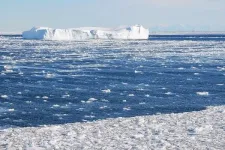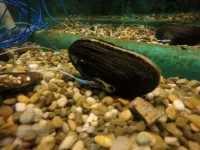Changes in Antarctic marine ecosystems
Intensity of phytoplankton production during Antarctic summer affects the structure of seafloor ecosystems
2021-03-23
(Press-News.org) Understanding the evolution of the polar sea ice is not enough to study the effects of the climate change on marine ecosystems in Antarctic seafloors. It is also necessary to determine the intensity of phytoplankton local production during the Antarctic summer, as stated in a new study by a research team of the Faculty of Biology and the Biodiversity Research Institute (IRBio) of the University of Barcelona, published in the journal Marine Environmental Research.
When the sea freezes in Antarctica
Extremely low temperatures, strong ocean currents and the broad seasonal coverage of marine ice are factors that determine the features of the Antarctic marine ecosystems. IN particular, the seasonality regarding the ice formation in the marine surface is a process that directly affects the dynamics of the marine ecosystems and the flow of matter and energy in complex Antarctic trophic networks. During the Antarctic winter, the ice and snow that accumulate limit the availability of light, and as a result, this reduces the activity of photosynthetic organisms and the production of krill (basic food resource within the food network in Antarctic marine ecosystems).
The main sources of organic carbon in Antarctic ecosystems located at the shallows are phytoplankton, algae that grow under the ice and algae that are stuck in rocks. However, great part of this primary production does not enter the trophic network directly through herbivores, but as detritus (particles of rock). "The presence of ice in the shallows limits the primary production during great part of the year. This determines that benthic trophic networks depend largely on the accumulated organic matter in seafloors during the summer months", notes Lluís Cardona, first author of the article and lecturer at the Department of Evolutionary Biology, Ecology and Environmental Sciences, and the IRBio.
"To date, we thought this dependence would be acute in areas where the sea surface remains frozen for a longer time, and this would involve a lesser diversity of trophic niches and a shorter and redundant trophic network while we go south", notes the researcher. The study highlights that the intensity of the summer bloom of phytoplankton alters this gradient and therefore the structure of coastal benthic systems is strongly modified wherever the bloom is intense.
Changes in Antarctic marine ecosystems
The study was based on the analysis of C and N stable isotopes to identify the ecological niche -the role of each organism in the structure and function of the ecosystem- of a series of marine species caught in Base Rothera, Cierva Cove, Maxwell Bay, Hope Bay, and Paradise Harbour, in the western side of the Antarctic peninsula, and Southern Shetland Islands. Using the isotopic analyses, experts could verify the great stability of the trophic level of each species but they also detected a considerable geographical variety in the used carbon sources. With the used methodologies in previous studies -in particular, the study of stomach content-, the obtained data provided a high taxonomic resolution but did not offer a complete version of the diet over time, which generated a great disparity in results.
According to the conclusions of the study, "where the phytoplankton production is intense, the benthic ecosystem receives lots of organic matter coming from the phytoplankton that becomes the basic source of carbon for benthic species, regardless of the latitude and length of the marine ice. This reduces the importance of benthic algae as a source of carbon, which is however very high since these are protected from herbivores by chemical defenses (repulsive natural products")", notes Lluís Cardona. Therefore, those areas that feature a summer bloom of intense phytoplankton, show a shorter and redundant trophic network, like in the sea surface that remains frozen for months. "Therefore, in order to assess the impact of climate change in benthic ecosystems, it is as much important to predict changes in summer production of phytoplankton as to simulate the length the ice will remain in the sea surface", notes the researcher.
A vulnerable polar region to climate change
The Antarctic peninsula is the most affected area by climate change in the white continent. According to current data, in winter, there is a reduction of the length of marine ice in the north, and a movement towards south regarding the species such as the Antarctic krill. Therefore, current conditions registered in the north of the Antarctic peninsula could be a model for the future of the southern-western peninsular areas as long as the summer production of phytoplankton remains the same, experts note.
INFORMATION:
The study was carried out with the support from the projects Distantcom and Bluebio, focused on biology and chemical ecology of Antarctic marine invertebrate communities and led by Professor Conxita Àvila (Faculty of Biology-IBRio), apart from the Alexander von Humboldt Foundation (Germany) and the Scientific Committee on Antarctica Research (SCAR).
[Attachments] See images for this press release:

ELSE PRESS RELEASES FROM THIS DATE:
2021-03-23
The rate of sea-level rise in the 20th century along much of the U.S. Atlantic coast was the fastest in 2,000 years, and southern New Jersey had the fastest rates, according to a Rutgers-led study.
The global rise in sea-level from melting ice and warming oceans from 1900 to 2000 led to a rate that's more than twice the average for the years 0 to 1800 - the most significant change, according to the study in the journal Nature Communications.
The study for the first time looked at the phenomena that contributed to sea-level change over 2,000 years at six sites along the coast (in Connecticut, New York City, New Jersey and North Carolina), using a sea-level budget. A budget enhances ...
2021-03-23
Researchers at North Carolina State University have designed and demonstrated a new system that allows them to remotely monitor the behavior of freshwater mussels. The system could be used to alert researchers to the presence of toxic substances in aquatic ecosystems.
"When mussels feed, they open their shells; but if there's something noxious in the water, they may immediately close their shells, all at once," says Jay Levine, co-author of a paper on the work and a professor of epidemiology at NC State. "Folks have been trying to find ways to measure how widely mussels or oysters open their shells off and on since the 1950s, but there have been a wide variety ...
2021-03-23
All viruses mutate as they make copies of themselves to spread and thrive. SARS-CoV-2, the virus the causes COVID-19, is proving to be no different. There are currently more than 4,000 variants of COVID-19, which has already killed more than 2.7 million people worldwide during the pandemic.
The UK variant, also known as B.1.1.7, was first detected in September 2020, and is now causing 98 percent of all COVID-19 cases in the United Kingdom. And it appears to be gaining a firm grip in about 100 other countries it has spread to in the past several months, including France, Denmark, and the United States.
The World Health Organization says B.1.1.7 is one of several variants of concern along with others that have emerged in South Africa and Brazil.
"The UK, ...
2021-03-23
Many organisms use sunlight to fuel cellular functions. But exactly how does this conversion of solar energy into chemical energy unfold?
In a recent experiment, an international team of scientists, including two researchers from UWM, sought answers using an advanced imaging technique called time-resolved serial femtosecond crystallography to watch a pigment found in some marine bacteria as it was exposed to sunlight outside the cell.
For this experiment, the researchers documented, for the first time, the dynamics of the "chloride ion-pumping rhodopsin," an atomic "pump," which is jump-started by sunlight and moves chloride ions unidirectionally into the ...
2021-03-23
DALLAS - March 23, 2021 - It's not just your legs and heart that get a workout when you walk briskly; exercise affects your brain as well. A new study by researchers at UT Southwestern shows that when older adults with mild memory loss followed an exercise program for a year, the blood flow to their brains increased. The results were published online today in the Journal of Alzheimer's Disease.
"This is part of a growing body of evidence linking exercise with brain health," says study leader Rong Zhang, Ph.D., professor of neurology at UTSW. "We've shown for the first time in a randomized ...
2021-03-23
A study of ancient bones shows that Early Neolithic sheep-breeders were faced with high levels of mortality among young animals in their herds. A statistical model, partly developed at Ludwig-Maximilians-Universitaet (LMU) in Munich, allowed the age distribution of the bones to be precisely determined.
In the 8th millennium BCE, early sheep-herders were already aware that the conditions under which their animals were housed had an impact on mortality rates among the lambs. This one result of a study researchers led by Nadja Pöllath (a curator at the State Collection for Anthropology and Palaeoanatomy in Munich), LMU zooarchaeologist Joris Peters (who is also the Director of the state collection) ...
2021-03-23
The BioRescue consortium develops and applies new technological approaches as a last straw for saving critically endangered species such as the northern white rhinoceros. Advanced Assisted Reproductive Technologies (aART) push the boundaries of what can be done to create new offspring. Consequently, new ethical questions regarding the application of these tools arise and need to be answered, and relevant animal welfare issues to be addressed. In order to ensure that the ethical risk assessment matches the technological breakthrough with aART, the BioRescue ...
2021-03-23
Despite guidelines promoting outpatient management of patients with low-risk pulmonary embolism (PE), few patients are currently discharged home from hospital emergency departments in the United States. That is the conclusion of a study titled Outpatient Management of Patients Following Diagnosis of Acute Pulmonary Embolism, published in the March 2021 issue of Academic Emergency Medicine (AEM), a journal of the Society for Academic Emergency Medicine (SAEM).
The retrospective cohort study of more than 61,000 patients treated at 740 acute care United States emergency departments during a two-year period sought to determine disposition practices and subsequent health care utilization in patients with acute PE. According to the findings, ...
2021-03-23
A study co-authored by researchers at the Johns Hopkins Bloomberg School of Public Health found that telehealth consults among privately insured working-age patients accounted for almost 24 percent of outpatient consults with health care providers during the early phase of the pandemic, March to June 2020, up from less than 0.3 percent during the same period in 2019.
The dramatic shift occurred as many medical practices halted or curtailed in-person office hours and patients stayed away from doctor's offices out of fear of transmission during the early months of the pandemic. At the same time, insurance companies and the federal government relaxed policies around telehealth to meet demand for remote medical consults ...
2021-03-23
Most people relate cholesterol to heart health, but it is also a critical component in the growth and spread of brain cancer. VCU Massey Cancer Center researcher Suyun Huang, Ph.D., recently discovered how cholesterol becomes dysregulated in brain cancer cells and showed that the gene responsible for it could be a target for future drugs.
The mean survival of patients with the most common and aggressive type of brain cancer, glioblastoma multiforme (GBM), is 14 months. The need to find new, effective treatments is urgent and has driven Huang, a member of the Cancer Biology research program at Massey, to detail ...
LAST 30 PRESS RELEASES:
[Press-News.org] Changes in Antarctic marine ecosystems
Intensity of phytoplankton production during Antarctic summer affects the structure of seafloor ecosystems





